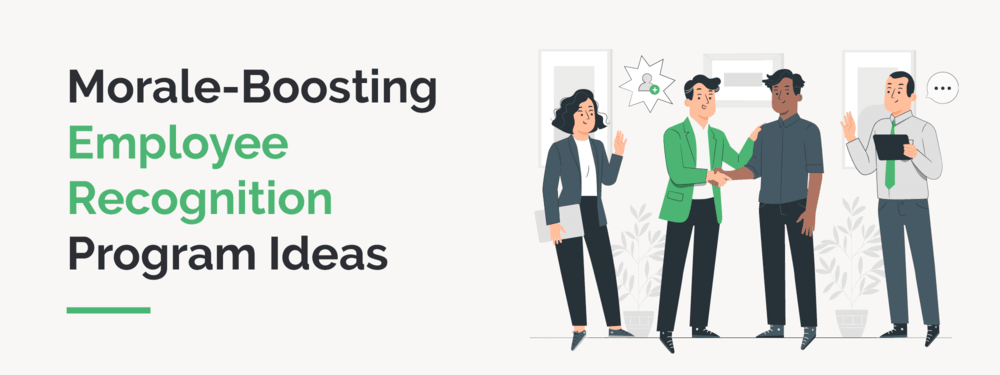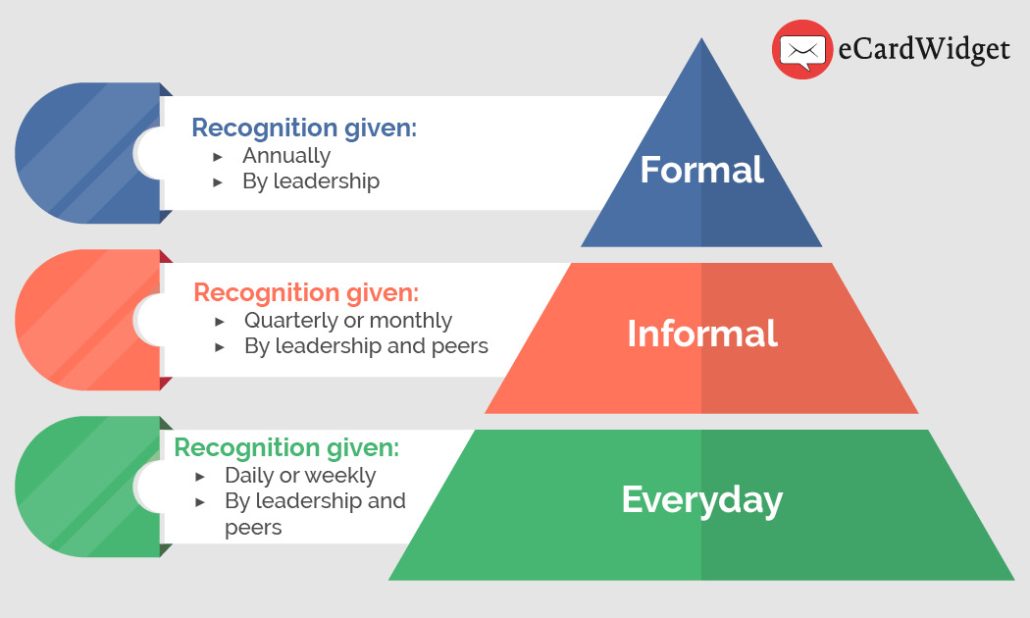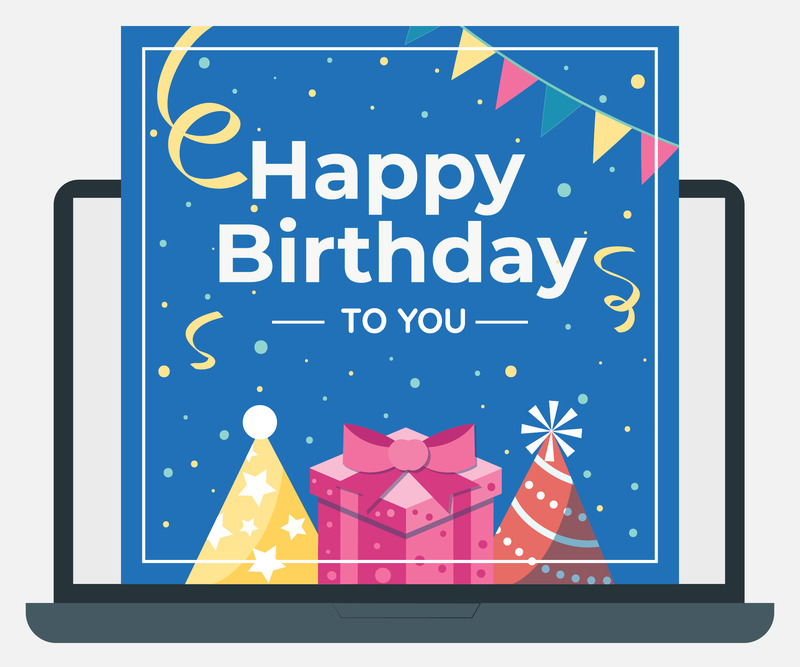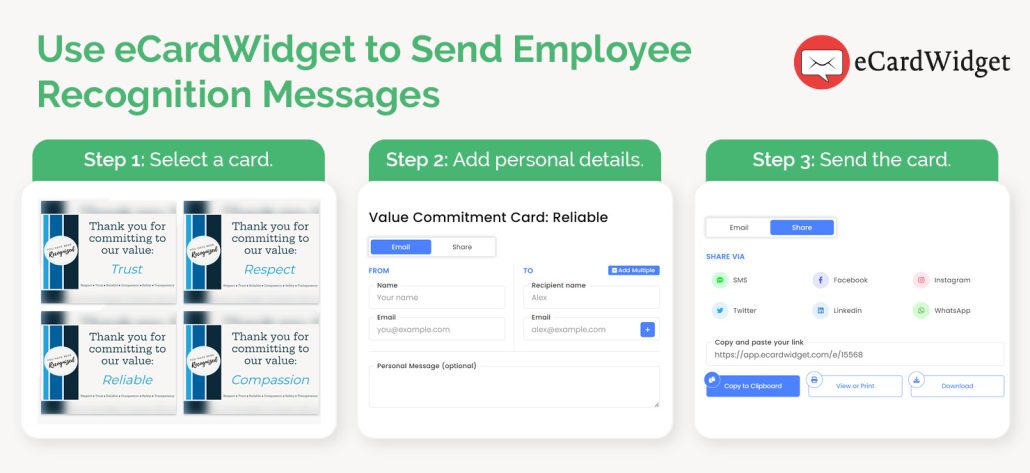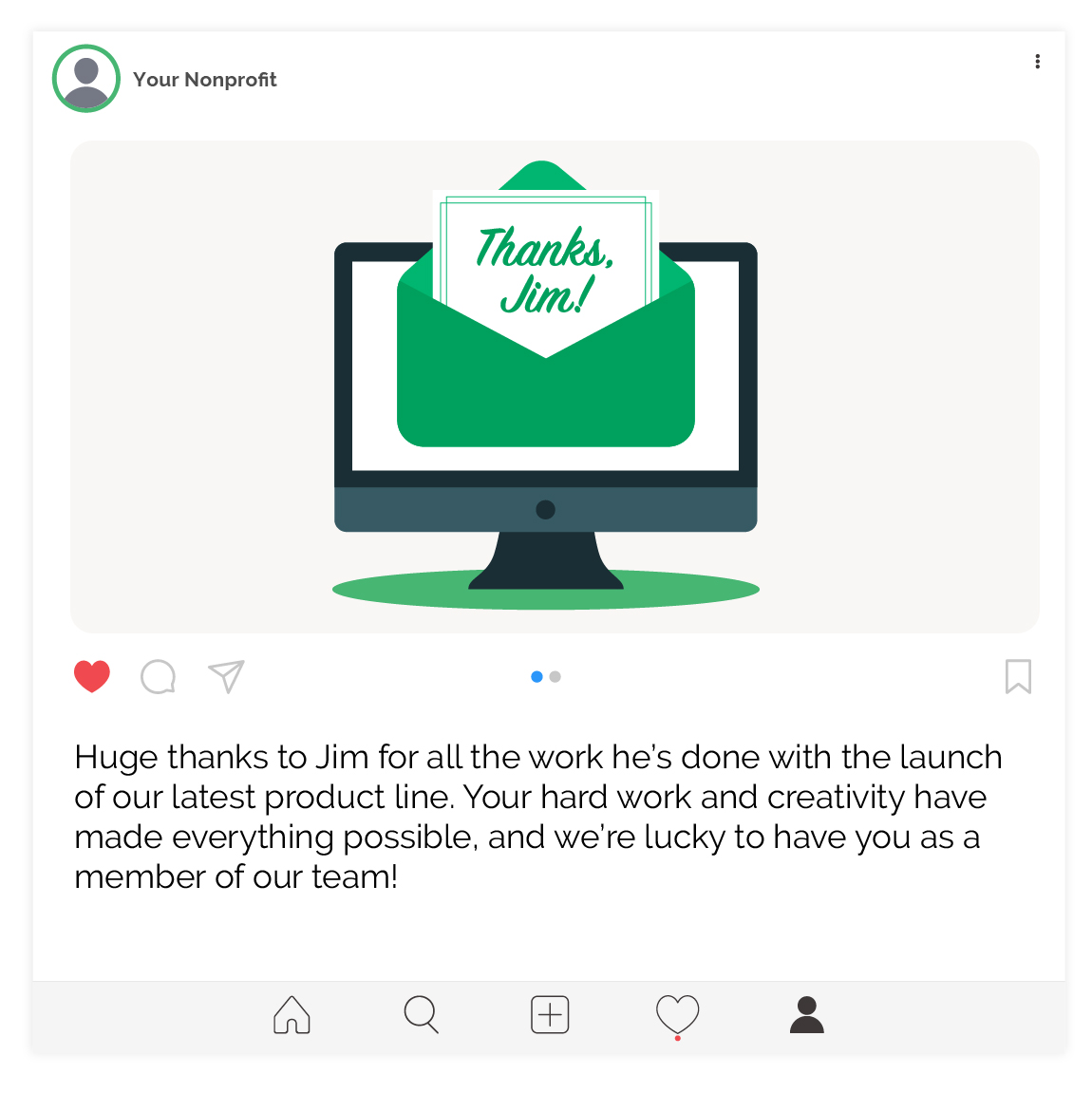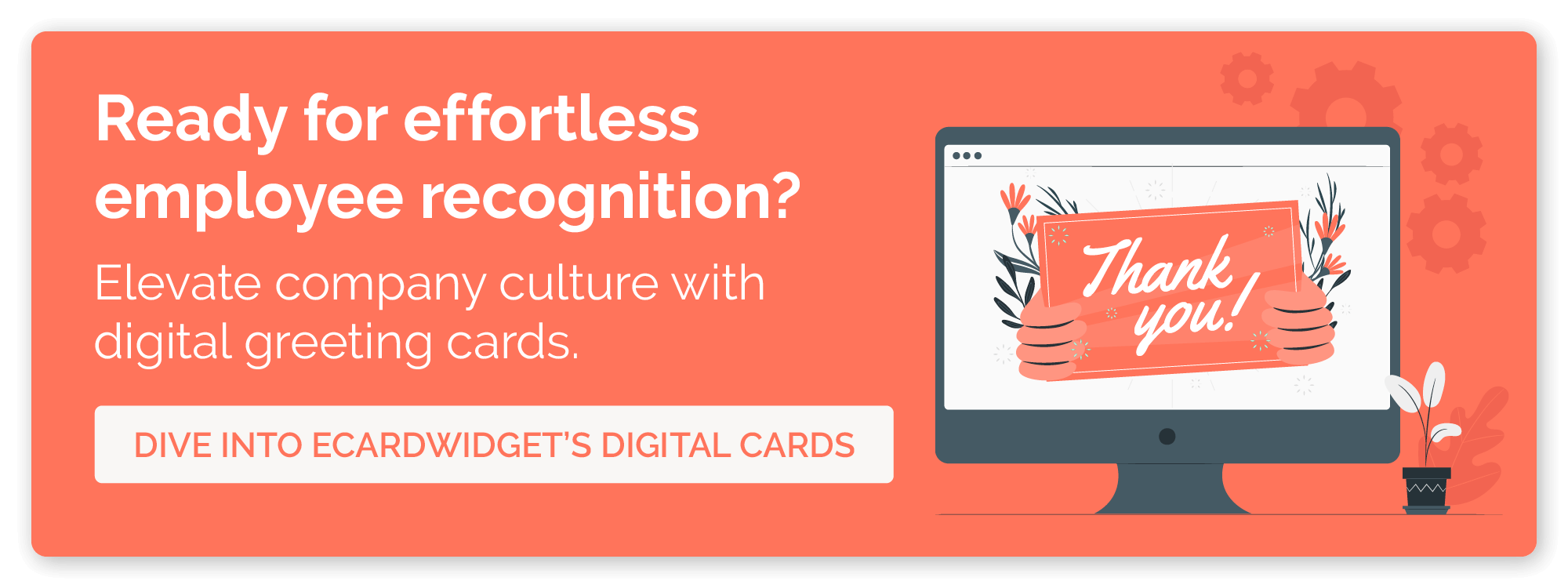How to Boost Morale: 10+ Employee Recognition Program Ideas
Picture this: You’re an upper-level manager at a corporate office. When you walk into the office one morning, employees seem motivated, are responsive to feedback and directions, and are generally energized and engaged.
You’re pleasantly surprised by the changes but wonder what sparked them. After speaking with one of your directs, you learn that they’ve introduced a few employee recognition tactics to increase motivation like sending eCards in response to a job well done. As a result, employees feel appreciated, are more connected to their teams, and are motivated to do their best.
To make this scenario a reality for your business, this guide will explore how your company can improve or start its own recognition program. Then, we’ll dive into a few of our favorite recognition ideas.
Why is employee recognition important?
Employees who feel recognized and appreciated tend to be more engaged, more loyal, and more reliable than those who feel a disconnect with their employer. There are many ways your business can cultivate an environment where employees feel motivated and ready to work, and showing adequate appreciation for a job well done is an easy, impactful first step.
To get specific about benefits, structured employee recognition programs can:
- Increase engagement and retention. One study found that employees who get regular recognition are up to eight times more engaged. When employees’ accomplishments are acknowledged and positively reinforced, they feel motivated to continue putting in effort at work. In turn, employees will be more productive, satisfied, and fulfilled, yielding higher retention rates and better quality work.
- Improve teamwork. By encouraging employees via recognition and urging them to recognize their peers’ accomplishments, your business can boost team morale and create a positive, collaborative work environment.
- Cultivate a more positive company culture. The above items are all important building blocks in constructing a positive work culture. Employees value and thrive in supportive work environments, and this can translate to higher-quality work that clients and customers notice.
To earn the benefits an employee recognition program can bring—many of which only materialize after long-term investment—you need a sustainable program that fits your organization.
When testing different approaches, start small to gauge employee interest and program effectiveness. You can make improvements along the way to ensure you’re investing time and effort into an appreciation strategy that resonates with your team.
What types of recognition should I show employees?
There is no “one size fits all” employee recognition program. Designing your program starts with determining the appreciation tactics that align with your workplace and employee preferences and the recognition software that allows you to enact those tactics.
Before brainstorming program ideas, ensure you understand the two key factors for any recognition strategy: how recognition is delivered and who delivers it.
Here are the three types of recognition that impact how the feedback is delivered:
- Formal recognition is usually structured, on a large scale, and planned ahead of time. This is the traditional type of employee recognition, often provided in the form of a bonus, raise, or positive performance review. Additionally, formal recognition almost always comes from managers, leadership, and other senior members of staff.
- Informal recognition is not an “organized” form of recognition and typically isn’t planned in advance. It tends to be small-scale and occurs sporadically. A few examples of informal recognition include giving a shout-out during a company-wide meeting, sending a peer an eCard, or deciding to buy the office lunch on a random day. Informal recognition can come from peers or leadership.
- Everyday recognition is even more informal than most types of informal recognition. As the name implies, this includes small, everyday gestures that demonstrate appreciation, such as thanking an employee for a good day of work when they leave the office. Everyday recognition can come from anyone at your workplace.
There are also differences in who recognizes employees’ work:
- Leader-to-direct recognition involves a leader giving feedback to a direct report. For instance, a manager might tell an employee that they appreciate them working hard to complete an urgent, unplanned project by its deadline to please a client.
- Peer recognition is given by an employee to a fellow peer. For example, one member of your sales team could shout out a fellow sales representative for giving them advice during a tricky client scenario.
With these distinctions in mind, your next question is likely: Which type should you focus on? The answer is all of them but to different degrees and at different times.
Let’s configure these recognition methods into an employee recognition pyramid with formal recognition at the top and everyday recognition at the bottom:
This visual arrangement shows how impactful each type of recognition is and how often it should occur, with formal recognition being given on an annual basis, informal quarterly or monthly, and everyday daily.
How can you start an employee recognition program?
After considering the types of recognition you’d like to show employees, you also need to plan out your program to ensure that it runs as smoothly as possible. Proper planning can help your employees feel appreciated right off the bat since it’ll be clear you put time and effort into creating your recognition program.
Important details to include in your recognition program’s plan include:
- Budget
- Frequency
- Recognition eligibility and criteria
- Selection process
- Rewards
Additionally, if you will need external help for your employee recognition program, such as from a third-party software vendor, you should outline that in your plan. For example, for an employee appreciation wall, set time aside to research and determine which business will create the plaques and how much it will cost.
What are the best employee recognition program ideas?
Outside of formal compensation changes that typically only occur one to two times a year, it’s important to recognize all of the progress and accomplishments your employees make between performance reviews.
Here are a few top employee recognition program ideas for your business to try:
1. Employee Gifts
Giving employees tangible gifts in return for their dedication and hard work is a great way to recognize them for both their day-to-day and larger-scale achievements. Because you can give them almost anything, this idea can adapt to fit many different scenarios by changing the value of the gift. For example, your business might purchase a $15 gift card to a coffee shop for someone’s birthday but reward them with a $100 coffee machine if they close a big sale.
When giving employee gifts, consider what items your employees will truly appreciate. Choose gifts that have an appropriate value and align with your employees’ interests, and consider how you can show company values through your gifts. For example, if you have a health-conscious or outdoorsy team, you might provide gifts that promote wellness, like a subscription to a meditation app or a desk treadmill.
To simplify the process, consider working with a corporate gifting company. These companies reduce the time and stress associated with gift-giving by offering curated gift selections that you can personalize. Plus, they’ll handle sending the gift straight to your employee, so you won’t have to worry about delivery yourself.
Top Employee Gift Examples
- Gift cards to local restaurants
- Tickets to a movie, museum, or other experiential activity
- Company-branded merchandise
- Donation to a nonprofit organization on the employee’s behalf, which we’ll explore more later
2. Milestone Celebrations
Acknowledge and celebrate employee milestones to show that you are following their progress and value their commitment to your organization. The two types of milestones you might choose to celebrate are:
- Professional milestones like 10 years at the company or a promotion
- Personal milestones like birthdays, anniversaries, or weddings
Tracking and recognizing milestones, whether personal or professional, shows that you care about your employees. This can be especially effective for building connections with employees who work remotely or in a hybrid environment since you likely get fewer opportunities to casually check in with them.
One milestone almost everyone celebrates is their birthday. Never miss an employee’s birthday by setting up automated emails.
Tools like eCardWidget’s automated birthday eCards help personalize this process. You’ll add employees’ birthdays to your contact list within the platform. Then, design celebratory eCards and craft message templates that eCardWidget’s platform will automatically fill in with personal details like the recipient’s name. If you select multiple eCard designs or write multiple birthday messages, the platform will cycle through them and send different combinations. This way, everyone will feel recognized on their special day!
Top Milestone Celebration Examples
- Significant “workiversaries”
Promotions or role changes
Retirement, particularly after many years at the company
Personal milestones like birthdays, weddings, or baby announcements
3. Recognition Awards
Recognition awards are given to reward your employees for work-related achievements. Offering awards can boost employees’ confidence and productivity, motivate them to keep up the good work, and may create a bit of friendly competition in some workplaces.
So, what deserves an official award?
The answer depends on your business and company values. For example, you might reserve awards for those who go above and beyond in their role or show that they work exceedingly well with others on their team. Or, your company can recognize and reward employees who receive positive feedback from their clients. Or maybe you want to encourage them to be self-sufficient and take initiative by giving awards to those who lead new projects or have innovative ideas.
Top Recognition Award Examples
- Certificates
- Plaques or trophies for formal, large-scale accomplishments
- A free meal or coffee
- Additional time off or the option to work remotely
4. Thank-You Notes
Thank-you notes are a simple, informal way to show employees appreciation quickly. For example, let’s say a manager notices that an employee completed all of their tasks ahead of schedule. They might send them an email thanking them for their efforts.
Rather than a plain, short email, use eCards to send thank-you messages. Brand these electronic greeting cards to your company and include custom images and text. Then, send them to recognize both in-person and remote employees. Because they can be sent to and from anyone, they’re suited to both peer recognition and recognition from leaders.
For eCard platforms, we recommend eCardWidget. With eCardWidget, you can create shareable eCards in just a few steps:
- Select a card to send. Create eCards with designs for different occasions, like thanking an employee for demonstrating a specific company value, wishing them a happy birthday, or welcoming them to the company. Remember to add employees’ birthdays and set up automated birthday eCards for streamlined birthday wishes!
- Fill in personal details. Address the eCard to its intended recipient. Then, fill in a personal message. Get specific by naming the exact achievement or action you want to recognize. Rather than saying, “Thank you for being responsive!” write a message like, “Thank you for responding so quickly to my email about an issue with a difficult client. It helped me resolve the problem in no time and impressed a picky client.”
- Send the message. Once your message is complete, send the email immediately or schedule it to be delivered later. You can also share the eCard via SMS, LinkedIn, and other social media platforms.
Our team at Double the Donation has adopted eCardWidget’s platform to ensure employees feel appreciated and understand the good work their colleagues are doing. Learn more about our approach and discover takeaways you can incorporate into your recognition strategy.
Top Thank-You Note Examples
- eCards
- Handwritten cards or letters
- Emails
- Group appreciation cards (i.e., everyone on your team signs a card)
5. Employee Recognition Spotlights
In addition to privately recognizing employees with thank-you notes, regularly acknowledge employees’ contributions publicly. Highlight their dedication, skills, or a particular idea they had to improve the business. You can also recognize any recent initiatives they pushed forward and explain how that initiative bettered the business.
To share their achievements with the rest of your team and even the wider public, consider featuring them in your newsletter, company website, or official social media pages like your LinkedIn. You might interview the employee to learn more about how they worked toward the accomplishment, which can even double as an educational guide for other team members.
If your company doesn’t use communication channels like newsletters or social media, consider giving them the spotlight during a company meeting. Recognize their efforts and give the rest of your team a chance to celebrate with them, whether it’s through clapping politely at an in-person meeting or sending positive messages in a Zoom chat at a virtual one.
Top Employee Recognition Spotlight Examples
- Post about the employee on social media or your website
- Choose and highlight a specific employee of the month/quarter
- Highlight an entire team
- Recognize innovative ideas in meetings each week
6. Matching Gifts and Other Charitable Giving Opportunities
Recognition is about your employees and the valuable work they do, and sometimes the best way to show your appreciation is by giving them the opportunity to give back.
If your business has an employee donation program, you may already be aware of the benefits of showing your team that their employer cares about the same causes they do. Helping employees make charitable donations or volunteer their time demonstrates that your business shares their values, which can help increase not only job fulfillment but also their positive feelings about their employer.
Often, employee donation programs are driven by employees and require them to sacrifice their time or part of their paycheck to make a difference. However, you can recognize employees and reward them with charitable giving opportunities where your business is the one fueling a donation, such as by providing the funds to make a financial contribution.
In particular, consider offering matching gift incentives. Some top matching gift companies offer donation ratios above the average 1:1 ratio. For employees who go the extra mile, consider matching their gifts at a 2:1 or even 3:1 ratio for a limited time, or let them choose a type of cause that you’ll increase your donation ratio for during a specific time period.
Top Charitable Giving Opportunities Examples
- Choose and highlight a specific employee of the month/quarter
- Highlight an entire team
- Recognize innovative ideas each week
7. Wellness Rewards
While this idea is similar to giving employees gifts, it focuses on wellness specifically. Show employees you value and support their well-being by gifting them goods and services that will improve their physical and mental health. These items could be anything from a one-month gym membership voucher to a weighted blanket to a book about work-life balance.
These gifts show that your business wants to invest in their health, and they can have major positive impacts on your company. Recognition-led wellness programs can protect employees from burnout which harms productivity, retention, and even your bottom line. With these programs in place, studies show that employees are up to 90% less likely to report feeling burned out on a regular basis.
For a real-world example of this program, check out Adobe’s Wellness reimbursement program, which reimburses employees and their families for up to $600 for purchases related to health and wellbeing.
Top Wellness Reward Examples
- Gift cards for a massage or spa treatment
- Wellness-related products (e.g., teas, essential oils, or yoga equipment)
- A subscription to a fitness app
- Gym membership voucher
8. Peer Recognition
Robust, frequent peer recognition is a great way to bring teams together, reinforce positive self-image, and improve employees’ confidence in their roles.
One advantage of peer-to-peer recognition is that while your leadership tries to adequately recognize all their employees, they can only see so much. With more eyes on the lookout for work that deserves to be recognized, more employees receive the appreciation they deserve, ensuring their accomplishments don’t fall through the cracks.
Make sure to share guidelines with your team about how to participate in your recognition program and make delivering positive feedback easy and approachable.
eCards are a great tool for peer recognition because they are convenient and easy for your entire team to use. If you plan to use eCards for peer recognition, send out instructions on how to create and send an eCard when you announce the program.
Top Peer Recognition Examples
- Notes, eCards, or emails to peers
- Kudos boards
- Recognition during meetings
- Small gifts or treats
9. Employee Appreciation Events
Take the time to celebrate everything your employees do for the business with periodic appreciation events. For instance, try hosting an office party or organizing a catered lunch after the entire office reaches your quarterly goal.
Keep employee-related holidays in mind, too. National Employee Appreciation Day, which falls on the first Friday of March, is a great opportunity to organize a free meal or office celebration for everyone. Additionally, check for holidays that are specific to your industry. For example, a tech company might celebrate National IT Professionals Day in September, and a school would observe Teacher Appreciation Week in May.
Top Employee Appreciation Event Examples
- Organize a company potluck or catering for the office
- Send gift baskets to remote employees
- Offer gift cards or vouchers
- Rent out a bowling alley or arcade for a fun night out
10. Employee Experience Programs
While not a recognition program in and of itself, one way you can create a more positive work environment and gauge your appreciation program’s success is by focusing on employee experience.
If you’ve heard of customer experience programs before, you essentially already know what employee experience is. For those new to the concept, customer experience programs assess every aspect of your customers’ interactions with your business through specialized surveys to identify pain points and resolve them. An employee experience program is the same thing but for your employees.
The employee experience process essentially goes like this:
- Employees are sent targeted surveys asking about their experiences.
- Employees identify common pain points in their workdays, which are also known as “moments of truth.”
- The surveys are elevated to the appropriate members of leadership to discuss and resolve pain points.
- The issues are resolved, and surveys are sent out at regular intervals to ensure the matter is now satisfactory and identify other pain points.
Like some of the other ideas on this list, setting up an employee experience program requires the right engagement software. There are many providers to choose from, but one of the first places to look is Qualtrics.
Qualtrics is the leading provider of essentially all types of experience programs, and if you’re looking for more specialized services, try exploring their partnership network to find an employee experience software vendor who fits your needs.
11. Learning and Development Opportunities
One of the best formal ways to recognize your employees for the hard work they do is to help them advance in their careers.
For the most part, we’ve shied away from providing advice on how companies should conduct formal performance reviews. However, here we want to emphasize how your business can build on or improve these conversations by opening up discussions to include how employees want to advance and grow their roles.
Having conversations about advancement is the first step. For interested employees, work with them to get them access to the learning and development opportunities they need to drive their careers forward.
Top Learning and Development Opportunities Examples
- In-house or third-party training courses
- New leadership opportunities
- Reimbursement for external training
Additional Resources
With diligent, dedicated effort toward employee recognition, your business can build a program that makes employees feel acknowledged and valued at your organization. The best way to encourage regular recognition is to make giving positive feedback and shoutouts easy for peers or managers to do—ideally on a weekly or daily basis.
eCardWidget supports employee recognition programs by streamlining the process. Book a demo to learn how to get these uplifting, personalized messages in your employees’ inboxes.
If you’re looking for more about improving employee engagement and building a supportive corporate culture, check out these resources:
- Empower Progress: 10+ Employee Engagement Software + Tips. Looking for tools to help you engage your employees? Check out this guide to using employment engagement software.
- A Full Guide to Employee Engagement Tools + 20 Top Picks. Support your search for the perfect employee engagement tool with this list of the top 20 software providers.
- Top Corporate Giving Software to Drive Employee Engagement. Corporate giving initiatives are the perfect complement to employee recognition programs. Learn about the top software providers to support workplace giving at your company.
